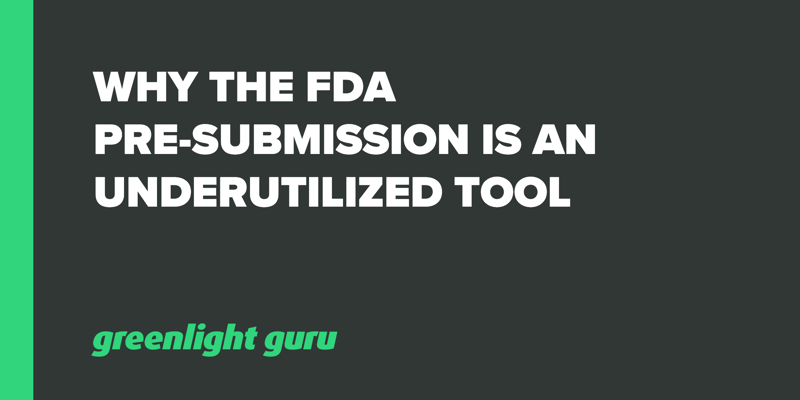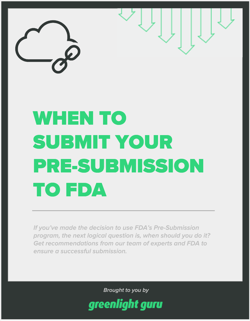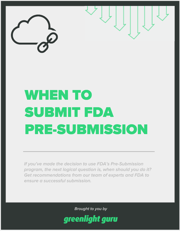
“I wish there was a way for the FDA to give me feedback about my medical device, prior to submission…”
That sentiment was really the basis behind the U.S. Food and Drug Administration’s (FDA) Pre-Submission program, which I discussed with medical device quality assurance and regulatory affairs expert David Amor during a webinar we did on the topic.
There is always uncertainty baked into any kind of government submission process, and it’s helpful to companies if there is a way to tackle issues before submitting a 510(k).
The FDA Pre-Submission is a way for companies to request feedback from the agency on potential and planned medical device, biologics and drug submissions. It’s a great service to take advantage of, only we’ve found that it tends to get underutilized.
Let’s take a look at the process and why we think it should be taken up by more medical device companies:
What is the Pre-Submission?
Pre-Submission allows you to request formal feedback on your medical device before you make the move to submit your 510(k). This is known as a Q-Submission, which under the guidance published by FDA, allows you to request the following:
- Pre-Submission (what we’re focusing on here)
- An informal meeting
- An agreement meeting
- Other (such as submission issues or study risk determinations)
The Pre-Submission process was born out of a need to provide expanded access to the FDA and allow companies to get valuable feedback ahead of time. This can help to keep your company on track for getting your device to market as soon as possible - it helps to be aware of possible issues ahead of time and deal with them before final submission.
The guidance for Pre-Submission is clearly laid out in the FDA document:Requests for Feedback on Medical Device Submissions. If you happen to have a combination product (such as a stent that administers a drug, or an inhaler), then there may be other, similar processes that you need to go through. The document to check out in that case is Guidance for Industry.
In any case, the basic definition of what a Pre-Submission is remains the same. It is a formal written request from an applicant/sponsor for feedback from FDA to be provided in the form of a formal written response, meeting or teleconference in which the feedback is documented in meeting minutes.
It’s a great way to meet with the FDA, ask them some questions, then document that information for future use. It boils down to identifying key issues that are keeping you up at night, and making your overall submission process easier.
FDA continues to expand its Pre-Submission program to include a number of different medical device submissions that a manufacturer may choose for bringing a device to market. The comprehensive list of submission types is known collectively as Q-Submissions(Q-Subs), which include:
E, De Novo request, 510(k), Dual, BLA, IND), Accessory Classification Request, or CW.
- Investigational device exemptions (IDE)
- Premarket approvals (PMA)
- Premarket notifications (510(k))
- Dual
- HDE – Humanitarian Device Exemption
- De novo requests
- Clinical Laboratory Improvement Amendments (CLIA)
- Certain Investigational New Drug Applications (IND) and Biologic License Applications (BLAs)
Our focus here is the 510(k).
Pros of Pre-Submissions
Should I really use a Pre-Submission? This is a key question that companies often ask, so it’s important to understand the relative pros and cons. Here are some of the pros:
- You develop a “human” relationship with the FDA. They are, after all, humans themselves and want to know who you are.
- You can remove some of the risk element from your submission. You get asked about things you don’t know as well as confirm things that you think you do know.
- You can get “free advice” to help drive your development and regulatory strategy.
- Sometimes the FDA will request a review of Pre-Submission materials, giving you a “bonus round” ahead of your 510(k) submission. This is a great opportunity to gain valuable feedback.
One thing to note is that you’re not getting a final acceptance at this stage; the FDA will never give you this until the actual submission. However, it’s well worth getting the early heads-up.
Cons of Pre-Submissions
There’s always a money and time aspect. You’re looking at $5,000 to $25,000 to have a consultant help you with a Pre-Submission. If all timelines are met, the typical process takes 60–75 days.
A con that is frequently raised is, “What if they tell us no and say we have to do X, Y, and Z instead of what we’re already doing?”
Our answer to this will always be the same: Isn’t it better to know about this now rather than go ahead with your 510(k) submission and find out then? The FDA will pick out that same issue regardless, so it’s a much better use of your time to have found out about it during a Pre-Submission.
Perhaps these cons are a big part of the reason that the Pre-Submission is underutilized, but I would strongly suggest that you don’t let them put you off using it. The FDA actively encourages medical device manufacturers to use the Pre-Submission because doing so helps the overall quality of the final submission.
The business case for a Pre-Submission
There's a great example of one experience David Amor shared with me about one of his clients, for which the Pre-Submission process saved all sorts of hassles further down the road for the company. This particular client thought their device was Class III, but the Pre-Submission process led to the realization that the device was, in fact, a Class II.
If you’ve spent any amount of time dealing with the different risk classifications, you’ll know that Class III devices are the most complex and require much more stringent regulatory controls due to the higher level of risk. Had that client not gone through Pre-Submission, it may have gone ahead with the higher level of testing and controls required by a Class III device, costing much more money and adding to the timeline before the device could get to market.
In this instance, the Pre-Submission saved money and time for the client, but this could also work the other way around—where you think you’ve put in place all that is required but find that the FDA expects more. No one wants to have a submission rejected and have to start the lengthy process all over again.
Pre-Submissions help you to gain an idea of what the FDA is focusing on. Listen to the questions its agents are asking you and pay attention to any areas that are emphasized: These need to be down pat for your final submission.
For some companies, particularly those in fundraising stages seeking an investment, a Pre-Submission provides a demonstration of value for the investor. It’s easier to convince someone if you’ve already had your device checked out by the regulator that has the final say in authorizing it. Although the FDA won’t provide you with advice on your pathway to approval, it will provide you with informal guidance.
Another good situation for considering a Pre-Submission is when you’re producing a new or novel device that the FDA needs familiarization with. Again, it’s about the FDA “getting to know you”—you can improve the quality of your submission and move the process along if the FDA already knows about you and is familiar with your new indication or technology.
Questions about planned non-clinical or animal studies, or questions about using data, are also good things to bring to a Pre-Submission.
One thing to note is that you should not be asking the question, “What testing do I need to do?” You want to be asking specific questions about the testing you already know you should and will be doing.
Final thoughts
The Pre-Submission program is a valuable tool that tends to be underutilized. Perhaps companies are put off by the idea that the process will take too much time and money, or they’re worried that FDA will tell them they need to do something that they hadn’t already planned on doing. (News flash: The agency will do this during submission, anyway.)
Our position is that a Pre-Submission generally makes good business sense. You have the opportunity to make yourself known to the FDA and can ascertain its position about things relevant to your submission.
Like many other medical device companies, you just may find it’s well worth the time and money.
Looking for a design control solution to help you bring safer medical devices to market faster with less risk? Click here to take a quick tour of Greenlight Guru's Medical Device QMS software →
Jon Speer is a medical device expert with over 20 years of industry experience. Jon knows the best medical device companies in the world use quality as an accelerator. That's why he created Greenlight Guru to help companies move beyond compliance to True Quality.
Related Posts
SaMD software documentation: 7 must-haves for premarket submissions
5 Tips to Help Your FDA 510(k) Submission (checklist included)
Submitting a 510(k)? First Make Sure You Know What 'Substantial Equivalence' Means
Get your free resource
When to Submit Your FDA Pre-Submission











